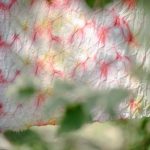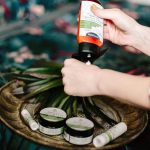Think of modal fabric as a sponge that not only soaks up water but also channels it away, keeping you comfortable in the heat. When you’re choosing clothes for a workout or a hot day, understanding the difference between moisture absorption and moisture wicking can change how you feel. Modal’s unique properties do more than just manage sweat—they interact with your body’s needs in surprising ways that might shift your perspective on performance fabrics.
Table of Contents
Key Takeaways
- Modal fabric rapidly absorbs moisture, pulling sweat away from the skin for a dry, comfortable feel.
- Its fibers wick moisture by distributing it across the fabric, promoting quick evaporation and preventing dampness.
- Modal combines the moisture absorption of cotton with the efficient wicking properties of synthetic fibers.
- The breathable structure of modal enhances airflow, aiding in temperature regulation during warm or active conditions.
- Modal’s dual moisture management makes it ideal for activewear and summer clothing, maintaining comfort and dryness.
Understanding Moisture Absorption in Modal Fabric
Although many fabrics claim to handle sweat well, modal fabric stands out because of its impressive moisture absorption capabilities.
When you wear modal, you benefit from its unique modal fiber properties that allow it to absorb moisture quickly and efficiently. Unlike synthetic fabrics, modal has excellent moisture retention, meaning it holds onto sweat without feeling damp or sticky against your skin.
This natural ability helps keep you comfortable throughout the day, especially in warm or humid conditions. You’ll notice that modal feels soft and breathable because it manages moisture rather than just pushing it away.
Understanding how modal absorbs moisture lets you appreciate why it’s a popular choice for clothing designed to keep you dry and fresh, even during active wear or long hours.
How Moisture Wicking Works With Modal
When you wear modal fabric, it doesn’t just absorb moisture—it actively moves sweat away from your skin to the fabric’s surface, where it can evaporate quickly. This moisture management enhances your comfort by keeping you dry and cool.
Modal’s fine, smooth fibers improve fabric performance by promoting efficient moisture transport.
Here’s how moisture wicking works with modal:
- Sweat is drawn from your skin into the fabric’s inner layers.
- Modal fibers distribute moisture across a larger surface area.
- The fabric’s breathable structure allows moisture to reach the outer surface.
- Evaporation happens swiftly, preventing dampness against your skin.
Comparing Modal’s Moisture Absorption and Wicking Properties
Because modal fabric combines both moisture absorption and wicking, it offers a balanced way to keep you comfortable.
When you compare modal’s characteristics to other fabrics, you’ll notice it absorbs moisture quickly like cotton but also moves it away from your skin efficiently, similar to synthetic fibers. This unique blend means you don’t have to sacrifice softness for performance.
Unlike pure cotton, which can stay damp, modal dries faster thanks to its wicking properties.
In fabric comparisons, modal stands out because it manages moisture in two ways: soaking up sweat and then spreading it out to evaporate. This dual action helps regulate your body temperature and keeps you feeling fresh throughout the day, making modal a smart choice for everyday wear.
Benefits of Modal Fabric for Activewear and Summer Clothing
If you’re looking for activewear or summer clothing that keeps you cool and comfortable, modal fabric delivers exceptional benefits. Its breathable comfort and lightweight texture make it a top choice when you want to stay fresh during workouts or hot days.
Here’s why modal works so well for your active and summer wardrobe:
- Moisture Absorption: Modal quickly absorbs sweat, keeping you dry without feeling sticky.
- Softness: Its smooth fiber feels gentle on your skin, preventing irritation.
- Durability: Modal maintains its shape and softness after repeated washes.
- Breathability: The fabric allows air to circulate, helping regulate your body temperature.
With modal, you get activewear and summer clothes that perform and feel great all day long.
Sustainability and Practical Uses of Modal Fabric
Although you mightn’t always consider the environmental impact of your clothing choices, modal fabric stands out for its sustainability and practical uses.
It’s made from beech tree pulp through sustainable sourcing, which helps reduce deforestation and promotes responsible forestry. Thanks to eco friendly production methods, modal uses less water and energy compared to conventional fabrics, making it a greener option you can feel good about.
Practically, modal fabric is incredibly versatile—you’ll find it in everything from underwear to activewear and even bedding.
Its softness, breathability, and moisture-wicking abilities make it perfect for everyday wear and outdoor activities. When you choose modal, you’re not only enjoying comfort and performance but also supporting a more sustainable fashion industry.
Frequently Asked Questions
How Do I Properly Care for and Wash Modal Fabric Garments?
You should follow washing tips like using cold water and gentle cycles to protect modal fabric. Avoid harsh detergents, and when drying, air dry or use low heat to maintain softness and prevent damage to your garment.
Can Modal Fabric Cause Allergic Reactions or Irritate Sensitive Skin?
You might not experience skin sensitivity or fabric allergies with modal fabric since it’s generally soft and hypoallergenic. However, if you have highly sensitive skin, test a small area first to avoid irritation or allergic reactions.
Is Modal Fabric Suitable for Cold Weather Clothing?
You’ll find modal fabric offers moderate thermal insulation, making it suitable for cold weather when you use it as part of layering options. It keeps you comfortable but usually isn’t warm enough alone in very cold conditions.
How Does Modal Fabric Compare in Price to Cotton or Polyester?
When you check modal fabric pricing, you’ll find it’s generally pricier than polyester but comparable or slightly higher than cotton. For a clear fabric cost comparison, consider quality and production methods impacting final prices.
Can Modal Fabric Be Dyed at Home Effectively?
About 70% of fabric dyeing happens industrially, but you can dye modal at home using fiber-reactive dyes. Just remember, mastering dyeing techniques guarantees better color fastness and vibrant results you’ll love wearing.
- Does Chiffon Fabric Stink - July 15, 2025
- Does Chiffon Fabric Affect the Economy - July 15, 2025
- Does Cotton Fabric Have a Nap - July 15, 2025







